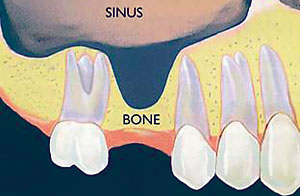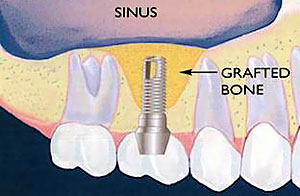Sinus Lifts and Bone Grafting for Dental Implants in Bradenton and Sarasota
Build a Strong Foundation for Dental Implants with Rubino Periodontics and Implant Dentistry
Bone grafting and sinus lifts are typically done before a dental implant procedure takes place, when there is not enough foundational bone to support the dental implant needing to be placed. It can also precede a variety of other procedures. Come see our highly skilled implant dentists in the Bradenton and Sarasota areas to learn more about preparatory bone grafting treatment.
Skilled Regeneration of Lost Bone
- The Causes of Bone Loss
- How Bone Grafting Works
- Advanced Technology for Minimally Invasive Procedures
- When We Do Bone Grafting
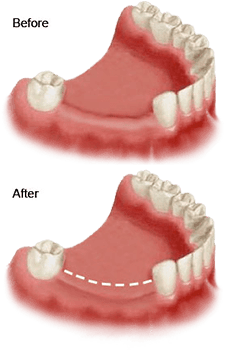 Your teeth are anchored in sockets on a platform of bone known as the alveolar ridge. Strong connective tissues (known as ligaments) and the surrounding bone firmly support your teeth and keep them stably in position on the ridge.
Your teeth are anchored in sockets on a platform of bone known as the alveolar ridge. Strong connective tissues (known as ligaments) and the surrounding bone firmly support your teeth and keep them stably in position on the ridge.
For various reasons, bone around your teeth can lose its volume and density. This can cause a variety of oral health problems, such as painful chewing and the loosening or loss of teeth. It can also be a stumbling block to placing dental implants, as implants need a certain amount of bone to be properly supported. Fortunately, Drs. Ryan, Tyler, and Thomas Rubino are able to regenerate lost bone and preserve your teeth and jaw through bone grafting.
Drs. Rubino – Your Bone Grafting Specialists
As a periodontist, your Dr. Rubino and his sons are highly trained specialists in grafting procedures that regenerate lost bone. They keep current with the latest research and advancements in bone grafting techniques so you will be provided with the highest quality treatment at all times. The use of advanced technology and materials makes bone grafting treatment precise, minimally invasive and efficient.
The Causes of Bone Loss
Below are the main causes of bone loss around your teeth:
- Gum disease – Bacterial plaque and calculus (tartar) emit toxins that eat away the ligaments and bone tissue surrounding the teeth. As the disease progresses in severity, the bone loss worsens until there is little or no support left for the teeth. This causes teeth to eventually be lost.
- A missing tooth – The bone surrounding your teeth needs stimulation from biting and chewing pressure to maintain its volume and density. When a tooth is missing, that pressure is absent and the bone gradually dissolves away.
- A misaligned tooth – A tooth can be misaligned so that it does not make contact with the teeth in the opposing arch when you bite down. This sometimes severely reduces chewing and biting pressure (which is needed to maintain the bone around the tooth) and can lead to bone loss.
- Infections in your jaw – Tumors, bacterial or viral infections not caused by gum disease can develop in the bone tissue surrounding your teeth and can result in bone loss.
- Injury to the tooth – Tooth injury can cause the tooth to be thrown out of its proper position or become infected. Either the misalignment or the infection can lead to bone loss around that tooth.
How Dentures Accelerate Bone Loss
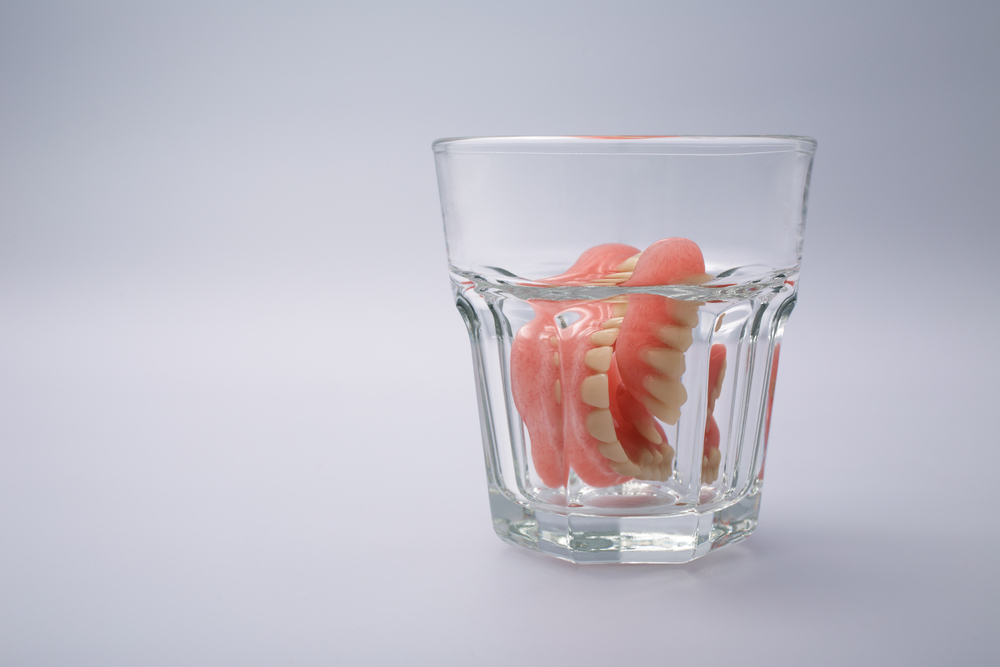
If you are wearing a traditional denture, the shrinking of your jawbone makes it necessary to continually refit the denture. The recurring lack of fit causes sore spots on your gums and can make chewing painful. It can get to a point where the bone loss is so severe that no denture will be able to fit snugly.
Why Bone Grafting is Performed
Bone grafts are placed to rebuild support for compromised teeth, to rebuild the structure of the jaw after tooth loss and to ensure adequate bone support for a dental implant.
To Build Support for a Compromised Tooth
A tooth that has lost supporting bone can become unstable and this can eventually lead to loss of the tooth. Bone graft material can be placed in the area of bone deficiency and rebuild proper support for the tooth.
To Preserve the Ridge After Tooth Extraction
After a tooth is extracted, bone loss tends to occur around the empty tooth socket. Drs. Ryan, Tyler, and Thomas Rubino will place a bone graft into the empty socket and generate the bone needed to preserve the ridge at its proper height, width and density. The regenerated bone will help support the adjacent teeth, and will simultaneously provide the necessary foundation for a future dental implant.
To Build Bone Support for an Implant
A dental implant needs adequate bone structure to be placed securely. When a tooth has been missing for a long time, bone loss has often occurred to such an extent that bone needs to be regenerated before an implant can be placed. When needed, a bone graft procedure will be performed so there is adequate bone for the implant to be stably anchored.
To Augment the Sinus Cavity Floor with a Sinus Lift
There are sinus cavities above the back teeth in your upper dental arch on each side of your face. When you lose a back tooth in your upper arch, the bone around the missing tooth causes the floor of the sinus cavity to “drop.” This bone loss can make the bone too shallow to support the full length of a dental implant.
In order to remedy this, bone graft material along the sinus cavity floor will be placed to regenerate the lost bone. This bone grafting procedure is known as a sinus lift.
What is Bone Grafting?
Bone grafting is a surgical procedure that rebuilds or strengthens areas of weakened jawbone, often performed as a preparatory step for dental implants. This process involves placing natural or synthetic bone material into areas where the jawbone has deteriorated due to tooth loss, gum disease, or injury. The grafted material serves as a scaffold, encouraging your body’s natural ability to regenerate new, healthy bone tissue.
Over several months, this new bone growth creates a sturdy foundation that can securely support dental implants. Though it may extend the overall treatment timeline, bone grafting is sometimes essential for successful implant placement and long-term oral health. The type of bone graft needed varies by patient and may be sourced from your own body, a donor, or biocompatible synthetic materials.
How Bone Grafting Works
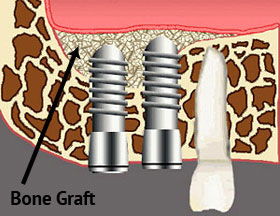
The graft material itself does not actually become the new bone. It stimulates the growth of new bone tissue by the body and acts as a “scaffold” (platform) around which the new bone can grow. The bone graft material itself harmlessly dissolves away as the new bone tissue fills the space.
Advanced Technology for Minimally Invasive Procedures
We use cutting edge technology in order to provide the most efficient treatment, with minimal down time.
Digital X-rays and 3-Dimensional CT Scans
Digital x-rays and 3-dimensional CT scans will be taken to inspect the bone levels around your teeth. When needed for even greater detail, additionally a 3D CT scan will be taken of your entire jaw with our cone beam 3D CT scanner.
The scanner produces crisp 360° digital images of your entire jawbone, teeth, and surrounding structures. These images can be viewed from any angle and magnified to get a closer view. 3D images can show the exact density and volume of the bone that surrounds your teeth.
Using these digital images, your doctor is able to precisely plan any necessary bone grafting procedures ahead of time and place the grafts efficiently.
Piezosurgery Device for Minimally Invasive Bone Preparation
Sometimes some diseased bone tissue needs to be removed or the bone grafting site needs to be made into the optimum shape for a graft to be placed. Using a piezoelectric surgery device Drs. Ryan, Tyler, and Thomas Rubino can gently sculpt the bone to accomplish this.
This instrument generates a micro-vibration that precisely sculpts bone but does not affect the surrounding soft tissues. This greatly minimizes trauma, is more precise and efficient, and makes the procedure minimally invasive.
What is a Sinus Lift?
A sinus lift, also known as sinus augmentation, is a specialized surgical procedure that adds bone to your upper jaw in the area of your molars and premolars. This delicate surgery involves carefully lifting the sinus membrane upward to create space between your maxillary sinuses and upper jaw, where bone graft material is then placed.
The procedure is typically necessary when there isn’t enough bone height in the upper jaw to support dental implants, or when the sinuses are too close to the jaw for implant placement. Common causes for needing a sinus lift include bone loss from periodontal disease, tooth loss, or naturally large sinus cavities. While more complex than standard bone grafting, a sinus lift has become a routine and predictable procedure that can significantly increase the success rate of upper jaw dental implants.
Frequently Asked Questions
How long does bone grafting take to heal?
Healing time typically ranges from three to six months, depending on the size of the graft and your body’s natural healing ability. During this time, your body will gradually replace the grafting material with new bone tissue.
Is bone grafting painful?
The procedure itself is performed under local anesthesia, so you won’t feel any pain during treatment. Some mild discomfort and swelling are normal during the first few days after the procedure, but this can be managed with prescribed or over-the-counter pain medication.
Can my body reject a bone graft?
Rejection is extremely rare with modern bone grafting materials. Whether using your own bone, donor material, or synthetic options, these materials are thoroughly tested and proven to be biocompatible. However, as with any surgical procedure, proper aftercare is essential for success.
How do I know if I need a bone graft?
Your dentist will determine if you need a bone graft through a comprehensive examination, including X-rays and 3D scans. Common indicators include significant bone loss from periodontal disease, long-term tooth loss, or insufficient bone density for dental implant placement.
What can I eat after a bone grafting procedure?
For the first few days, stick to soft, cool foods and liquids. Avoid hot foods, hard or crunchy items, and drinking through straws. Your doctor will provide specific dietary guidelines based on your procedure.
Pave the Path to a Restored Smile with Supplemental Dental Implant Surgery
At Rubino Periodontics and Implant Dentistry, we understand that the prospect of bone grafting or sinus lift procedures can seem daunting. However, these proven and predictable procedures are often crucial steps toward achieving a fully functional, healthy smile with dental implants.
Our experienced team, led by Drs. Ryan, Tyler, and Thomas Rubino, combines advanced technology with gentle, personalized care to ensure the best possible outcomes for our patients. Whether you need a simple bone graft or a more complex sinus lift procedure, we’re here to guide you through every step of your dental restoration journey.
Call to request an appointment: Sarasota/


